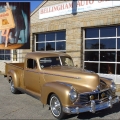More wire harness quanderings
Since working on the last two Hudson wiring harnesses, I wonder why the factory did not use more colors
in the wiring system to ID each circuit? For example, black is used in multible circuits that use different wiring sizes but the same black covering. I have thought of taking the factory schematic and change out the circuits
with the same color (black for instance) to black/white, black/red and so on. At the end of the day, because this changes the "stock" status due to wire color and covering material, I think I will go with a Painless harness system. This will also allow me to add a fuse bank and put it in an accessable location.
in the wiring system to ID each circuit? For example, black is used in multible circuits that use different wiring sizes but the same black covering. I have thought of taking the factory schematic and change out the circuits
with the same color (black for instance) to black/white, black/red and so on. At the end of the day, because this changes the "stock" status due to wire color and covering material, I think I will go with a Painless harness system. This will also allow me to add a fuse bank and put it in an accessable location.
0
Comments
-
I’ve used a couple of Kwik Wire, Harnesses. They have a mounted fuse panel with a built in kill switch, and all the wires are stamped and labeled and long enough to mount the fuse panel where ever you would like. On my 46 I put it behind the left kick panel with an access flap. Sometimes it’s easier to mount the fuse panel on the passenger side where there is more room. Kwik Wire
has a web site and they are made in the USA.0 -
Im certainly going to look into that company. Thanks for the info.
0 -
I created my own wiring harness on my 48 by following the wiring diagram in the repair manual and using wire from Home Depot. if took a while but by adding two fuse boxes I feel a lot better knowing that each accessory has its own individual fuse in case of an electrical short. On my 49 I I used a harness from American Autowire, and it worked out even better. $350 and I put the fuse panel in the place where the driver side glove box would be on a Commodore.0
-
I’m pretty sure I used a 12 circuit on my 46 Hudson pickup, and on my 40 Hupmobile. Neither one has power windows or power door locks. Both had built in wires for electric fuel pump.in case you want to install one or not.0
-
I switched to GXL/TXL wire several years ago from GPT (Primary) wire. I also skin a portion of the insulation off the end of a new roll of wire and measure the actual wire with a mic to see if is the actual guage specified. Foreign made wire is often undersized.
Here is some info from
SELECTING AUTOMOTIVE WIREWhen in doubt, use 125°C rated TXL, GXL, SXL, or SGX wire insulation for engine compartment and general wiring. The only difference between these is the thickness of the insulation and cost, with the thicker being the more expensive. They are all insulated with crosslinked polyethylene, which is almost as heat resistant as teflon, but cheaper and much tougher.
The wire available in your local automotive or hardware store is insulated with PolyVinyl Chloride (PVC). PVC is OK for cool areas, but NOT under the hood. The PVC will melt at temperatures that don't affect the HDPE! For more detail, see wire tables and amps vs wire size.TXL Automotive WireTXL is the wire used by vehicle manufacturers for most applications, and is the thinnest, lightest, and lowest cost of these insulations. It is also tough and long lasting.Click Here
To order 18 to 12 Gauge TXL WireGXL Automotive WireGXL is an intermediate insulation,with thickness and cost between TXL and SXL.Click Here
To order 18 to 14 Gauge GXL WireSXL Automotive WireSXL is the second thickest of the crosslinked polyethylene insulations, and suggested for use in heavier gauges, or where additional protection from possible mechanical damage is needed.Click Here
To order 12 to 6 Gauge SXL CableSGX Automotive WireSGX is the thickest of the crosslinked polyethylene insulations. SGX is particularly recommended for battery cable, because of the rather spectacular consequences of a shorted battery cable.Click Here
To order 4 to 1/0 Gauge SGX Cable
NOTE: SAE J1128 GPT is a PVC insulated wire rated at 85°C used for general chassis wiring, and should NOT be used in the engine compartment of your car according to the SAE J1128 spec. It's not as tough or heat resistant as TXL or GXL insulation, although it is significantly cheaper.
This is the wire found in retail stores.
0
Categories
- 36.9K All Categories
- 112 Hudson 1916 - 1929
- 20 Upcoming Events
- 92 Essex Super 6
- 28.6K HUDSON
- 571 "How To" - Skills, mechanical and other wise
- 995 Street Rods
- 151 American Motors
- 178 The Flathead Forum
- 49 Manuals, etc,.
- 78 Hudson 8
- 44 FORUM - Instructions and Tips on using the forum
- 2.8K CLASSIFIEDS
- 608 Vehicles
- 2.1K Parts & Pieces
- 77 Literature & Memorabilia
- Hudson 1916 - 1929 Yahoo Groups Archived Photos


